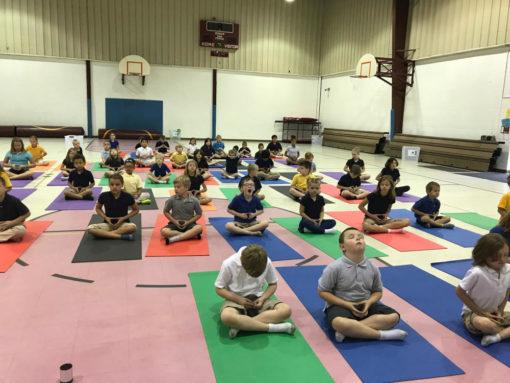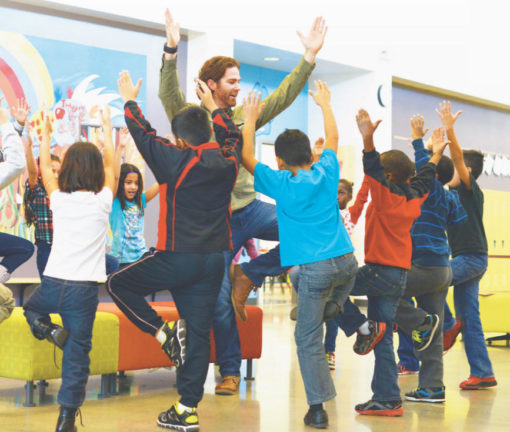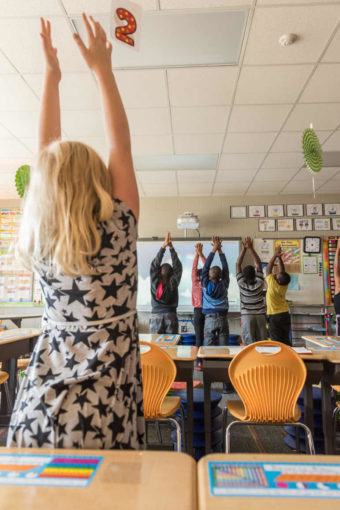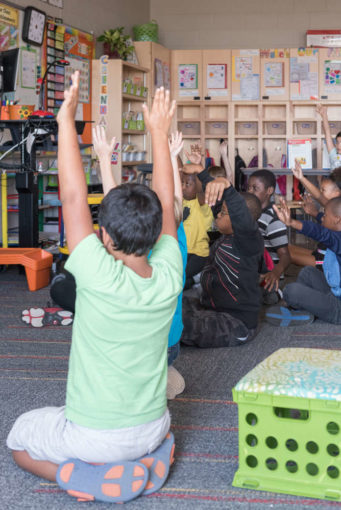Elementary teachers bring yoga and mindfulness into Iowa classrooms

Afternoon recess is over, and Gina Ferrel’s fourth grade class is filled with giggling, twirling, desk-slamming chaos.
“Find your spread-out yoga spots,” the teacher says. As kids scatter, Mrs. Ferrel brings up on the smartboard a video from the mindfulness activity website GoNoodle. The screen fills with clouds and sunshine.
“This is exactly why we do yoga,” she explains gently. “We came in from recess and we are worked up. But we need to get calm with our yoga, and it starts now. You know I expect 100 percent.”
Cross-legged on the carpet, the kids follow the video’s voiceover instructions, taking a deep breath in through their nostrils as they stretch their arms up above them, then releasing it slowly in a soft hiss as arms float back to sides. Some close their eyes. The action is repeated nearly a dozen times, first sitting, then standing. “Enjoy the rainbow you’ve created,” the video says.
Long before the sequence is complete, the tenor of the class has shifted to calm silence. Mrs. Ferrel inaudibly prompts her students to retrieve books from their desks and begin quiet reading.
The activity is quick and simple, but has been tied to a significant decrease in suspensions and disciplinary trips to the office since yoga was introduced at Alexander last year.
Seeing yoga and meditation in an Iowa classroom is not unusual, but it is fairly new. Studies released over the last 10 years connecting yoga, meditation and mindfulness exercises to improved behavior and test scores from students have encouraged many educators to implement some form of yoga practice into their schools. From individual teachers leading mindfulness lessons centered on food or art, to principals contracting professional child yoga instructors to train their whole staff on flows, breaths and mundras, classroom yoga takes many forms — all, apparently, to the benefit of students.
Challenge to Change
“Our minds are meant to think, think, think and our bodies are meant to move, move, move,” said Molly Schreiber, who, with her program Challenge to Change, instructs schools on how to innovate yoga practice.
Schreiber, RYT-200 95-RCYT, discovered a passion for children’s yoga in the wake of her husband Kyle’s death from a car accident. In 2012, she started Challenge to Change out of her hometown of Dubuque, through which she combines child development research with yoga and mindfulness practices to tailor activities, materials, lesson plans and training to be used by educators.
Her classroom activities include simple sequences like Sun Salutations as well as breathing exercises and creativity-boosting games or crafts — all designed to connect mind, body and breath. She has adapted mudras, or symbolic hand gestures, that kids can match to their moods, and utilizes eye pillows to help students meditate.

“A lot of kids don’t know what it feels like to fully relax,” said Schreiber, a former elementary teacher with master’s degree as a reading specialist. “When you turn inward and you shut off the lights and close your eyes, there’s scientific research that says the power of just doing that will lower your heart rate and relax your body and mind.”
Inspired by the work of mindfulness author Susan Greenland, child psychologist Christopher Willard, musician Kira Willey and studies such as those of clinical psychologist Patricia C. Broderick connecting emotional awareness to higher cognitive function, Schreiber’s goal is to show educators that mindfulness exercises improve the mental and physical health of young students.
Schreiber may get that opportunity this school year. Challenge to Change received a $20,000 grant from the McDonough Foundation — which donates funds for health and educational efforts in Eastern Iowa — for a study of the effects of yoga in classrooms. Positive findings could have a number of ramifications; for example, Iowa school districts may consider training guidance counselors on mindfulness, which could save schools the cost of hiring outside instructors.
Schreiber has already begun implementing her program in four Dubuque elementary schools for the 2017-18 school year, as part of the study. Two of the schools, Fulton and Lincoln, represent the district’s highest percentage of students receiving free and reduced lunch; the other two, Sageville and Kennedy, are considered the most affluent schools in the district.
“We’re really hoping to show with the study that it doesn’t matter what the socioeconomic status is, all schools need this,” Schreiber said.
School demographics, provided by principals and staff, help Schreiber and her team of instructors adapt lesson plans to the study body’s specific needs, whether it be poor communication or anxiety from high parental expectations.
Before training the staff on yoga, Schreiber instructs teachers to meditate for 30 days and gain a sense of mindfulness.
“It’s like the oxygen masks on an airplane,” Schreiber explained. “If you don’t put the oxygen mask on yourself first, you can’t help the people around you. It’s the same thing for the teacher: They really have to put the oxygen mask on themselves first before they can put it on kids.”

A school full of yogis
At Edmunds Elementary in Des Moines, yoga is considered fully implemented. This means all students begin the day with a yoga routine, and select a personal “go-to breath” depending on their moods. A kindergarten teacher could stop a stressed-out fifth grader in the hall and ask for her go-to breath — Balloon Breath, perhaps, involving a deep-belly inhalation — and encourage the student to keep up with the calming exercise throughout the day.
“It’s just part of our daily routine,” Edmunds principal Jaynette Rittman said. “Part of our normalcy.”
When mindfulness concepts are understood schoolwide, students are surrounded by the tools and resources they need to remain grounded. That was Rittman’s goal when she sought out a yoga program three years ago.
“There were a lot of incidents where a student looked at another student funny and they would just hit each other. There was no self-regulation going on,” she said. Student conflict can be exacerbated by language or cultural barriers, and Des Moines public schools — including Edmunds — comprise of immigrants and refugees of nearly 200 different countries, from Sudan to Syria to Thailand.
Yoga programs lessen the need for discipline, according to Edmunds’ former English Language Learning (ELL) teacher Dustin Hockman.
“The whole purpose is to teach skills and strategies to help prevent whatever behavior issue there may be,” said Hockman, a certified yoga instructor. “It’s more than just poses … it puts them in situations where they learn to take care of each other and learn about differences.”
Since Edmunds first began applying yoga and mindfulness techniques in 2014, office referrals for behavioral transgressions were cut in half from about 1,000 a year to between 400 and 500. In addition, Edmunds students’ Iowa Assessment scores have increased 18 percent in reading, 18 percent in science and 17 percent in math.
“Just the overall climate and culture is a building for learning and you can feel that,” Rittman said. “If you’re implementing it well people will notice that as soon as they walk in the building.”
For her school’s yoga makeover, Rittman secured a number of state and local grants to contract Yoga 4 Classrooms, a children’s yoga company out of New Hampshire that offers 67 research-based yoga and mindfulness activities for students across six categories: Let’s Breathe, At Your Desk, Stand Strong, Loosen Up, Imagination Vacation and Be Well.
In 2014, Rittman and 10 faculty members traveled to New Hampshire for the initial training from Yoga 4 Classrooms founder Lisa Flynn. They ended up “revamping” the provided curriculums to make them their own.
Rittman had to add 10 minutes to the beginning of the school day to accommodate the yoga interventions. When students complained the exercises felt repetitive, staff added a twist.
“We started doing more flows within lessons, all based around various social topics or areas we feel like we wanted to address as a school,” Rittman said. “If we’re all talking about citizenship or giving compliments, the whole school is talking about that.”
Other schools have taken notice. This summer, groups of educators from Des Moines, Cedar Rapids and even Texas visited Edmunds’ annual Yoga 4 Classrooms retraining.
Hockman warns that the transition took time — not every student felt comfortable striking a Warrior Three Pose in front of peers off the bat. But mindfulness eventually leads to a more mature student body.
“[If you’re acting angry] students will call you out and say, ‘Mr. Hockman, do you need to do a yoga breath?’” he said with a laugh. “It’s awesome … They know why we’re doing this.”
Lessons in empathy
Some Iowa teachers are completely independent in their pursuits. Suzanne Yoder, a fourth grade teacher at Mid-Prairie West Elementary in Wellman, was encouraged by her own experience combating anxiety and depression. She said a mental health course at the University of Iowa saved her — she uses knowledge from that class, curricula from the science-based activity site MindUP and further research to inform her lessons.
“After taking the course myself, it was very apparent that it would be beneficial if I taught young students how the brain works, how to regulate their emotions and work through anxiety and depression before the stress of high school and later years,” Yoder wrote in an email.
Yoder leads her class in mindfulness exercises such as taking 15 minutes to eat and experience peanut butter pretzels with all five senses. She also had students share their emotional reactions to a Jackson Pollock print, then create their own art outdoors.
“I frequently end the day with the question, ‘What was the best part of your day?’” said Yoder, a teacher for 23 years. “I have had several reply that the best part was mindfulness and if we could do more the next day, it would be even better.”
One student approached Yoder asking if mindfulness might help his uncle, who is suffering from depression. When a student’s father died unexpectedly last year, she said the lessons helped the children cope.
“The kids felt safe expressing their feelings, both to the class and to the student,” Yoder said. “I have [seen] empathy levels that I normally do not see with fourth graders.”
Treating trauma
Located within eyeshot of grazing black cows and eastern Iowa City farmland, Alexander Elementary is one of the area’s newest schools, opening in 2015. Many students are refugees from African countries; one-third are in ELL and speak little to no English. Seventy-four percent of kids are on free and reduced lunch programs. Last year, more than 40 students came from homeless families.
“A lot of our students have a lot of barriers to learning and that comes out in physical aggression, anger, disrespect,” said Principal Chris Gibson. “We knew we had lots of trauma, and we needed to learn as much as we could.”
In summer of 2016, Gibson had her staff study the book Fostering Resilient Learners: Strategies for Creating a Trauma-Free Classroom by Kristin Souers with Pete Hall. The resulting discussions lead to her decision to gradually begin yoga and mindfulness training at Alexander.

Librarian Amber Austin — who, as an English teacher at Iowa City West High School, received praise from students after using yoga to reinforce lessons on Transcendentalism — is Alexander’s yoga leader, and a certified yoga teacher. She taught a new pose to the student body every Monday morning last school year until all were mastered, including Downward Dog, Savasana and Crow Pose, which was renamed “Falcon Pose” in reference to Alexander’s mascot.
Teachers are largely responsible for leading their own mindfulness lessons, but enthusiasm for the program varies amongst teachers, and many lessons rely on smartboard videos. Austin doesn’t see this as a negative. The “beauty of yoga,” she said, is that there is no formula or manual, which affords both teachers and young yogis agency.
Alexander’s first year of yoga was, ostensibly, a success. The number of office referrals for negative behavior dropped 12 percent between the 2015-16 and 2016-17 school years; suspensions decreased by 36 percent; some classes so enjoy yoga they will choose extra yoga time over additional recess; and a voluntary all-school yoga gathering at the end of the school year attracted more than 100 students. Gibson described one such student who has made a 180-degree turn as a result of yoga.
“He was very impulsive and quick to anger, and now he is one that eats it up,” she said. “He loves it — he is a yoga leader in his class. His mom and dad considered taking him to yoga outside of school, and they actually went and toured Maharishi [a consciousness-based preparatory school in Fairfield, Iowa] thinking that might be better for him because of that.”
Does yoga bring religion into schools?
No matter the success of yoga programs, one of the most common arguments against introducing yoga and meditation into public schools is that it would violate the “freedom of religion” provision of the First Amendment. This, of course, assumes the practices are religious in nature.
While yoga and meditation are often combined with spiritual observance — as per the Niyama, the second of the eight limbs of yoga, which encourages one to develop a spiritual character — classroom yoga instructors are quick to defend their lessons as merely physical and emotional counseling.

Western culture supports this. A vast majority of U.S. yoga classes are secular and practiced by yogis of myriad faiths. For better or worse, the most popular “brand” of yoga is one stripped of reference to God, deities, prayer or worship. A judge in California echoed this, characterizing yoga in the U.S. as “a distinctly American cultural phenomenon” in a 2013 ruling against a group of Christian parents who hoped to have yoga banned from state schools as a Hindu ritual.
Still, school yoga leaders remain aware of concerns. Instead of rebranding yogic practices “lifestyle fitness,” as one Catholic college in Kansas did this year, Iowa’s teachers have made their own accommodations.
Suzanne Yoder, who teaches in a conservative community, is careful to avoid association with yoga, and considers her work to be lessons in mindfulness. Molly Schreiber more than welcomes the word yoga at Challenge to Change, but prefers “mindfulness” when referring to meditation-like activities with kids.
“Sometimes it can hit that funny little line. I never, never om in schools, ever,” Schreiber said. “I’m very careful in educating the teachers in what yoga is, what meditation is and where those religious barriers are.”
Namaste — often interpreted to mean “I bow to God” or “I bow to you” — is disputed. While Jaynette Rittman’s Yoga 4 Classrooms curriculum forgoes what she considers a religiously-connotative term, Schreiber has merely adapted it.
“When we do namaste in school I tell the kids that it means ‘the light in me sees the light in you.’ So what it really means is you’re telling someone ‘I think you’re pretty awesome.’”
Schreiber is prepared to dispel fear from educators, parents or others.
“I give my own personal story about how I’m a practicing Catholic,” she said. “In my house you will see crucifixes, and if you go to someone’s house who is Hindu who practices yoga, you’re going to see statues of deities. That’s just how it is.”
Edmunds’ ELL teacher Dustin Hockman said in the beginning of Edmunds’ yoga implementation, a handful of students with religious, predominantly Muslim, parents were instructed not to participate. Out of context, Hockman said they may see the prayer-like hand position of Tree Pose and other postures as worshipful. But clear communication always won the day.
“If I had a girl who came to school and said she can’t do it anymore … I made sure to get a translator or I myself would talk to parents,” Hockman said. “I never had issues after talking to parents and explaining the benefits.”
Rittman expressed that skeptics, no matter their objections, should always keep student wellbeing at the forefront — and that may mean infusing classrooms with funny-looking poses, videos of rainbows or the tide-like sound of Ocean Breaths.
“Ask yourself, does tradition top what’s best for kids?” Rittman said. “Or do you do what’s best for kids, even if that involves thinking outside the box?”
Emma McClatchey is YogaIowa’s managing editor and the editorial assistant at Little Village magazine. She grew up in Iowa City and studied journalism, English and anthropology at the University of Iowa. This article was originally published in YogaIowa’s Fall 2017 issue.


